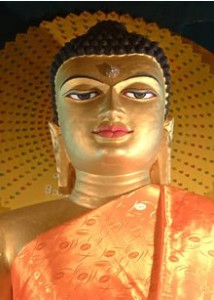The following is an excerpt from a public talk given by His Holiness Khenpo Jigme Phuntsok in Washington D.C.
This is the auspicious occasion which commemorates the precious turning of the Dharma Wheel which occurred in ancient India by our Lord and Supreme Guide, Lord Buddha Shakyamuni, in Varanasi in the presence of the five disciples and hundreds and thousands of gods and other exalted beings who gathered. At that time the Buddha gave the teaching on the subject of the Four Noble Truths. Since this is the special day of that teaching, I would also like to mention a little about the Four Noble Truths.
OM YE DHARMA HE TU PRA BHA WA HE TUN TE KHEN TA THA GA TO HAYA WA DET TE KHEN TSA YO NI RO DHA EWAM BHADI MA HA SHRA MA NA YE SO HA
I have just recited what is called the essence mantra of interdependent origination, which is what the Buddha first uttered on that occasion. First the Bhagawan Lord Buddha Shakyamuni spoke four words which had to do with understanding the truth of suffering, the cause of suffering, the cessation of suffering and the path which leads to the cessation of suffering. These four points were explained according to their essential nature. Secondly, he explained how it is that we can recognize what suffering is, what causes suffering, what causes the cessation of suffering and what practices are the actual practices that comprise the path leading to the cessation of suffering. And thirdly, he explained what the situation was like when suffering is alleviated, when the causes of suffering are alleviated, when the cessation occurs and the actual fruition of the path. After explaining the Four Noble Truths in these three ways, Lord Buddha Shakyamuni was able to lead those five disciples, who themselves were all Arhats, and those hundreds and thousands of gods and exalted beings who had gathered to realize the fundamental nature of reality, the nature of the dharmata. Although the Buddha himself only uttered twelve words, because those who were gathered there were not ordinary and had tremendous faith and devotion and fervent regard, they were able to actualize the full understanding of the teaching and realize the meaning based on that direct transmission.
Now I would like to very briefly go back and explain the meaning of what Lord Buddha taught on that occasion. These are like condensed teachings that came in words, but the explanations that came after the first explanation were for those who were on the Bodhisattva bhumis, and so they could understand the meaning. Therefore I would like to explain the first series of teachings on the nature of suffering, which is something that we can relate to. What I will be drawing from at this point is a teaching which was actually written down, or compiled by, Maitreya. To cite an example: If one is suffering from a disease or an illness, first one has to recognize what is the cause of that disease in order for the suffering to be alleviated. The second step would naturally be to recognize what causes the disease. One must then be careful in terms of what food one eats and one’s activity and conduct so as to not create those causes. One must uproot the causes which produce that unwanted result. To completely eliminate that disease, one has to understand very clearly the benefit of the elimination or the cessation of that disease. Considering that one can then be free from suffering if the cause of the disease is eliminated is not enough. One must actually engage in whatever activity is necessary to make the elimination of the disease occur, which is in fact partaking of the medicines which are potent enough to actually destroy the disease. Therefore this points to the path. In terms of spiritual practice, one has to know how to pursue the path to eliminate suffering.
